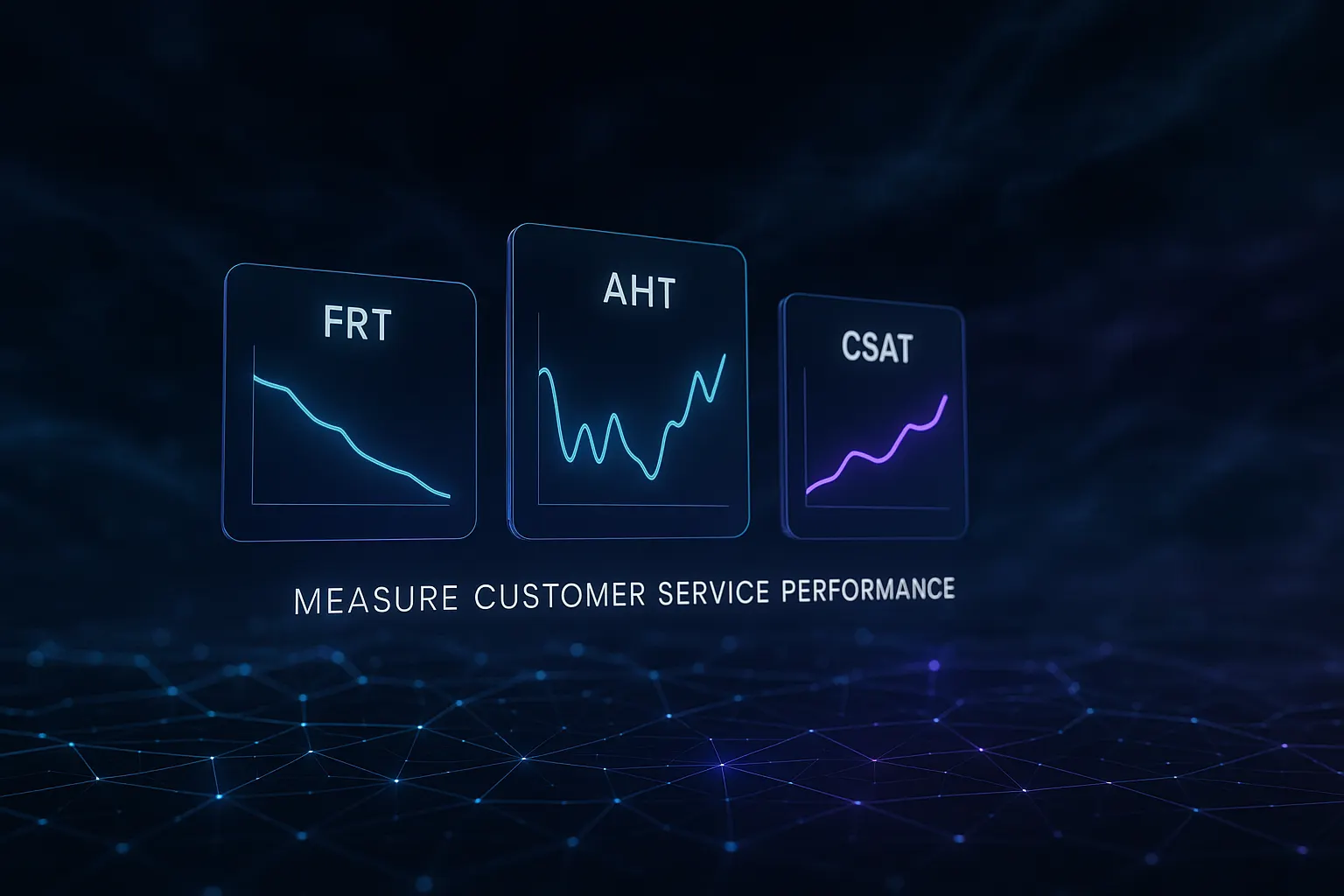Stop guessing. Let three signals guide your support.
Support teams often track dozens of metrics, but only a select few truly guide day-to-day performance. First Response Time (FRT), Average Handle Time (AHT), and Customer Satisfaction (CSAT) offer a holistic perspective, combining speed, efficiency, and customer sentiment. Consider these KPIs as an interconnected system, not as isolated statistics.
You may be operating in a startup environment or at a similarly fast pace. Volume surges, product changes, and lean staffing are par for the course. These three KPIs help you stay focused and adapt intentionally. Measure them accurately, review results frequently, and take action on all three in combination.
- First Response Time (FRT) reveals how swiftly your team acknowledges a customer inquiry.
- Average Handle Time (AHT) shows how much time is spent resolving each case, from start to finish.
- Customer Satisfaction (CSAT) captures how customers rate their experience after receiving support.
Keeping a balance matters. A shorter First Response Time (FRT) can harm Customer Satisfaction (CSAT), particularly if replies appear insubstantial. Similarly, a lower Average Handle Time (AHT) could negatively affect the quality of resolutions. Calibrate your goals by channel, support tier, and issue type.
FRT: the moment that sets the tone
First Response Time measures the interval between a customer submitting a ticket and your first non-automated, human reply. For chat, this is the first agent’s message; for email, it’s the first personal response. Automated acknowledgments are not counted toward FRT.
How to calculate FRT
FRT = first_agent_reply_timestamp − ticket_created_timestamp
- Set a clear business hours policy; consider pausing the clock outside of those hours if appropriate.
- Exclude any internal escalations that occur before the first customer-facing reply.
- Segment FRT data by channel and priority, average figures can obscure important spikes.
Practical starting targets
- Email: under 2 hours during business hours.
- Chat and in‑app: under 60 seconds from queue entry.
- Social and communities: under 30 minutes for public posts.
Improve FRT without gaming it
- Sort incoming queries by customers' specific intentions and preferred languages at intake.
- Bring relevant context from CRM and billing systems directly into the agent’s dashboard when a case opens.
- Leverage AI-driven tools to draft initial replies, then personalize them before sending.
- Follow a “first helpful response” approach, offer value in the first reply, not just greetings.
For evidence of real progress from AI-enhanced workflows, review our analysis of 38% customer service efficiency gains with AI. This study highlights measured improvements, not just vanity metrics.
AHT: the truth about handling effort
Average Handle Time (AHT) sums the total time spent actively working on a case, including note-taking and any necessary research. For chat and phone, remember to include wrap-up time; for email, count writing and investigation periods.
How to calculate AHT
AHT = (total_handle_time_across_cases) ÷ (number_of_cases)
- Define what is included in “handle time” for your team and document it for consistency.
- Exclude idle queue time, but include time spent on transfers or holding.
- Monitor medians and p90 values to capture outliers and spot trends.
Reduce AHT by removing friction
- Use AI-powered drafting that respects your brand’s tone and policy.
- Auto-insert dynamic snippets containing accurate product or account information.
- Integrate knowledge resources directly into the reply editor to streamline agent workflow.
- Minimize rework by providing clear templates for complex support flows.
Remember, shorter is not always better. Alongside AHT, track your resolution rate and reopen rate, as these can provide insights into efficiency and the quality of initial resolutions. If the rate of reopened cases increases while AHT drops, you may be prioritizing speed at the expense of clarity or completeness.
CSAT: sentiment that maps to moments of truth
Customer Satisfaction (CSAT) gauges how the customer feels after their interaction. Typically, this is gathered via a concise survey presented soon after problem resolution. Keep the survey simple and timely for the best results.
How to calculate CSAT
CSAT = (positive_responses ÷ total_responses) × 100%
- Use a straightforward 1 to 5 scale with clear labels for each option.
- Include one optional open-ended question to add context.
- Survey across a variety of channels and times to avoid sampling bias from only easy wins.
Raise CSAT without chasing vanity
- Focus on empathy in communications. Clarify next steps and timelines for resolution.
- Provide specific solutions rather than generic promises.
- Escalate cases promptly when they carry significant impact or urgency.
- Use feedback themes from survey comments to inform future product and process improvements.
Fast is kind. Clear is kinder.Use both in every reply.
Set targets and SLOs that fit your stage
Your goals should align with your unique customer base and support realities, not with generic benchmarks. Use broad initial ranges and tighten them as the team’s capacity and capabilities mature.
Channel-specific suggestions
- Chat: FRT under 60 seconds; AHT under 8 minutes for tier-1 issues.
- Email: FRT less than 2 hours; AHT less than 20 minutes for tier-1 requests.
- Priority cases: FRT below 15 minutes, regardless of time of day.
Make targets trustworthy
- Define all KPI formulas clearly in your support playbook.
- Randomly audit at least 10 cases weekly for accuracy and consistency.
- Report both the 50th and 90th percentiles, along with reopen rates, alongside each KPI.
- Reward team members for achieving high-quality resolutions, not just for speed.
How the three KPIs work together
Approach your customer service KPIs like a portfolio, each indicator informs the others. Good FRT shows customers their issues are being considered, which earns their attention. Efficient AHT management ensures a smooth, flowing process. Finally, strong CSAT scores build trust over time by indicating consistently satisfying service experiences. Monitor how changes in one metric affect the others.
- If FRT increases but CSAT remains stable, you may be facing volume strain, consider optimizing routing or increasing staff.
- If both AHT and CSAT decrease, rushed resolutions could be impacting customer sentiment. Strengthen your guidance and quality controls.
- Very high AHT with high CSAT could hide inefficiency, enhance your team’s access to information and knowledge resources.
Use these insights to shape weekly team reviews, plot trends collectively, and drive open discussions about trade-offs and improvements.
Tools to improve your FRT, AHT, CSAT
Numerous platforms claim to boost these KPI scores. Focus on finding tools that fit your workflow, privacy policies, and data needs. Here is a brief, unbiased comparison of such platforms:
- Zendesk AI: Seamless with Zendesk, offering intelligent routing and helpful macro suggestions.
- Typewise: AI-driven writing designed for support teams; integrates with CRMs and email systems; built for privacy from the ground up.
- Intercom Fin: Effective for in-product chat and self-service customer support journeys.
- Salesforce Einstein Service: Especially robust if your operations are centered on Salesforce.
- Ada and Ultimate: Best suited for organizations seeking scalable automation and guided case flows.
Choose solutions that comply with your data standards and match your preferred workflow style. Request trial periods during which you can assess the effectiveness of the tools using tangible metrics. Always compare FRT, AHT, and CSAT both before and after implementation.
Instrumentation checklist you can deploy this week
- Clearly define KPI formulas and share them throughout your team.
- Tag cases by intent, product category, and priority tier.
- Set up routing rules for languages, urgency, and account types.
- Integrate your CRM, ticketing, and knowledge resources on a single platform.
- Incorporate AI-powered drafting tools that allow customizable templates and easy incorporation of citations.
- Launch a concise two-question CSAT survey on all resolved cases.
- Publish a live dashboard displaying the 50th and 90th percentile for each KPI.
- Hold weekly quality review sessions on a random sample of 20 tickets.
Make the numbers serve the conversation
Metrics should facilitate deeper, more meaningful conversations with customers. Use FRT to greet customers with purpose. Use AHT to identify and eliminate sources of friction. Use CSAT to discover the moments that matter most.
If you’re aiming to lower FRT and AHT without compromising CSAT, let’s connect. See how Typewise can support your workflow and meet your data standards. Start a short conversation with the Typewise team.
FAQ
Why are FRT, AHT, and CSAT important in customer support?
These metrics together provide a comprehensive view of your support operations, covering response speed, efficiency, and customer sentiment. Ignoring any one of them jeopardizes your ability to deliver satisfactory service, leading to dissatisfied customers and potential churn.
Can a low First Response Time really harm Customer Satisfaction?
Absolutely. Faster responses that lack substance or miss the customer's needs can frustrate users and erode trust. Fast but unhelpful replies can result in a poor support experience, ultimately lowering satisfaction rates.
How can Average Handle Time affect the quality of support?
Focusing solely on minimizing handle time can lead to rushed interactions and unresolved issues. If agents are pressured for speed, they might provide incomplete solutions, resulting in dissatisfied customers and repeat inquiries.
Is it possible to have high CSAT and high AHT simultaneously?
Yes, and it's a warning signal. High satisfaction scores despite long handling times may indicate that customers value thorough solutions over speed. However, consistently high AHT could mask efficiency issues needing urgent attention.
What are the risks of overly focusing on one KPI, such as CSAT?
Overemphasizing CSAT can cause neglect of operational efficiency and response speed. This singular focus might lead to superficial service improvements while underlying operational issues remain unaddressed, harming long-term service excellence.
How can AI tools impact these customer support metrics?
AI can enhance all three metrics by optimizing workflows and providing faster, contextual replies. However, reliance on AI must be balanced with proper customization to avoid depersonalized interactions that fail to address specific customer needs comprehensively.
Are automated replies counted in First Response Time?
No, automated replies are not considered in FRT measurements. FRT assesses the time taken for a human agent to respond, ensuring the metric reflects meaningful customer engagement rather than automated acknowledgments.
What should be prioritized when improving KPIs in customer support?
Focus on a balanced strategy that integrates speed, efficiency, and customer satisfaction. Prioritizing one metric over others can result in short-term gains but may undermine long-term support quality and customer loyalty.
Can rushing to improve Average Handle Time lead to negative outcomes?
Yes, improving AHT at breakneck speed can compromise service quality. An aggressive focus might push agents to submit incomplete resolutions, leading to repeated inquiries and dissatisfied customers.


![[2026 Update] Best Canned Responses for Customer Support (Copy & Paste)](https://cdn.prod.website-files.com/6808ed5445a2321fbfcc156c/6932980e9debe1f6dc59a4d4_image_xnm0at.webp)


